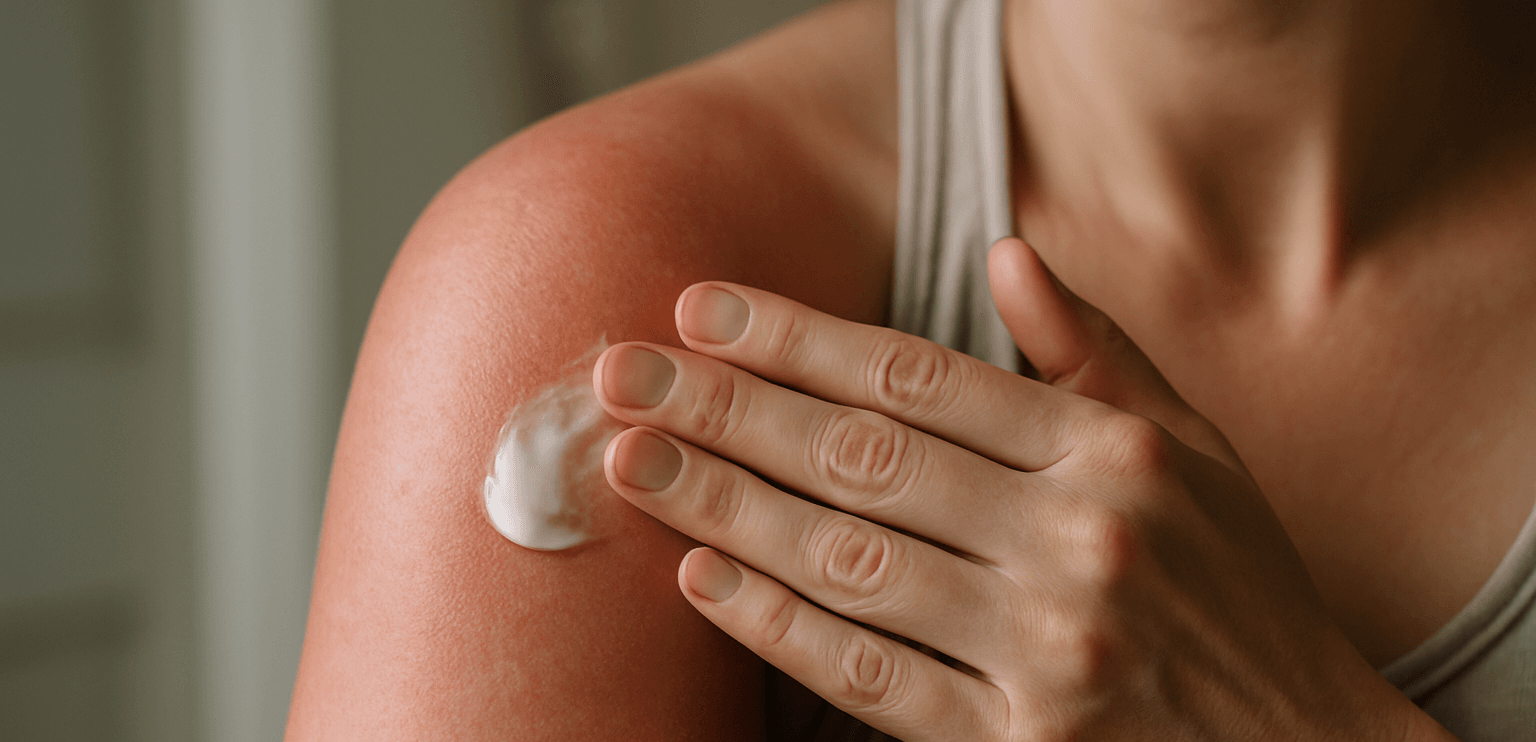Sunburns are a common and painful consequence of excessive sun exposure. Even with diligent sunscreen application, you might find yourself with that familiar stinging, red skin. Understanding how to treat a sunburn effectively can minimize discomfort, promote healing, and prevent long-term damage.
Immediate First Aid: Get Out of the Sun!
The very first thing to do when you realize you’re burned is to get out of the sun immediately. Seek shade or go indoors to prevent further damage. Sunburns draw fluid to the skin’s surface, so it’s vital to replenish fluids by drinking plenty of water to avoid dehydration.
Soothe and Cool the Burn
Cooling the Skin: Take frequent cool showers or baths to relieve pain. You can also apply cool, damp cloths to the affected areas. Avoid ice or ice packs directly on the skin, as this can cause frostbite and further damage.
Moisturize: Gently pat your skin dry after showering and apply a moisturizer containing aloe vera or soy to soothe the burn. Aloe vera gel is widely recommended for its cooling and anti-inflammatory properties. Avoid petroleum-based products like petroleum jelly for severe sunburns, as they can trap heat.
Topical Treatments: Calamine lotion can also help relieve discomfort. For mild to moderate sunburn, a nonprescription 1% hydrocortisone cream can be applied to reduce inflammation three times a day for up to three days.
Pain Relief
- Over-the-Counter Pain Relievers: Aspirin or ibuprofen can help reduce swelling and discomfort. Acetaminophen can also be used. Follow the label instructions for dosage. Remember that aspirin should not be given to children under 16.
Dealing with Blisters
Leave Blisters Intact: If your skin blisters, it’s a second-degree sunburn. Do not pop the blisters, as they protect the skin from infection and aid healing.
Protect Blisters: Keep blisters clean and apply petroleum jelly to protect them. If a blister breaks, trim the dead skin with clean scissors, gently clean the area with mild soap and water, apply antibiotic ointment, and cover with a non-stick bandage.
Hydration is Key
Sunburns draw fluid to the skin’s surface and away from the rest of the body, potentially leading to dehydration. Drink plenty of water to help your body recover.
What to Avoid
Petroleum Jelly: Avoid applying petroleum jelly to sunburnt skin, especially on severe burns.
Ice: Do not apply ice or ice packs directly to sunburnt skin.
Popping Blisters: Avoid popping blisters to prevent infection.
Scratching Peeling Skin: Do not scratch or try to remove peeling skin.
Tight Clothing: Avoid wearing tight-fitting clothes over sunburnt skin.
Alcohol-based Products: Avoid products containing alcohol, as they can further dry out the skin.
Certain Topical Ointments: Ointments or lotions containing local anesthetics (e.g., benzocaine) or diphenhydramine should typically be avoided because of the risk of allergic contact dermatitis.
When to Seek Medical Attention
While most sunburns can be treated at home, it’s essential to recognize when medical attention is necessary. Seek medical help if you experience:
- Severe Blistering: Extensive blistering.
- Signs of Infection: Increased pain, swelling, redness, pus, or fever.
- Dehydration: Dizziness, headache, and decreased urination.
- Fever or Chills: A high temperature (38C/100.4F or above).
- Heat Exhaustion: Weakness, nausea, or vomiting.
- Sunburn in Infants: Sunburn in babies less than 1 year old should be treated as an emergency.
- Underlying Conditions: Patients who have a bad sunburn in addition to medical conditions that make it harder to heal, such as diabetes, vascular insufficiency, or heart, lung, or kidney problems.
A doctor may recommend a prescription corticosteroid cream for severe sunburns. In very severe cases, hospital treatment may be necessary.
Long-Term Healing and Prevention
Protect from the Sun: Cover sunburnt skin from direct sunlight until fully healed. Continued sun exposure will only worsen the burn and increase the risk of long-term damage.
Gentle Exfoliation: As the skin heals, it may start to peel. Resist the urge to pick at it. Instead, gently exfoliate in the shower and continue to moisturize.
Prevent Future Sunburns: Sunburns increase the risk of premature skin aging and skin cancer. Protect your skin by seeking shade, wearing sun-protective clothing, and using a broad-spectrum, water-resistant sunscreen with an SPF of 30 or higher. Reapply sunscreen every two hours, or immediately after swimming or sweating.
Additional Tips
Treat Sunburned Eyes: Apply a clean towel dampened with cool tap water to closed eyes. Do not wear contacts until your eye symptoms have gone away, and avoid rubbing your eyes.
Oatmeal or Baking Soda Baths: Adding oatmeal or baking soda to a cool bath can soothe sore skin.
Replenish Electrolytes: Consider drinking electrolyte-rich beverages to help restore balance, especially if you are dehydrated.
Dealing with a sunburn can be uncomfortable, but prompt and proper care can provide relief and support healing. Remember to protect your skin from further sun exposure and take preventive measures to avoid future burns.

